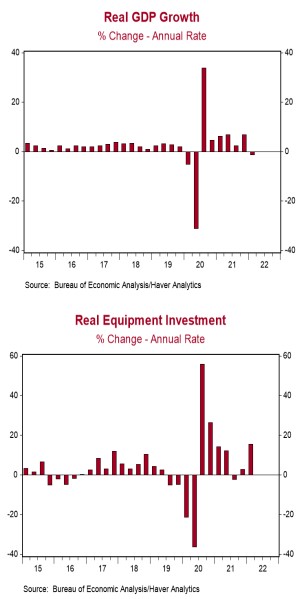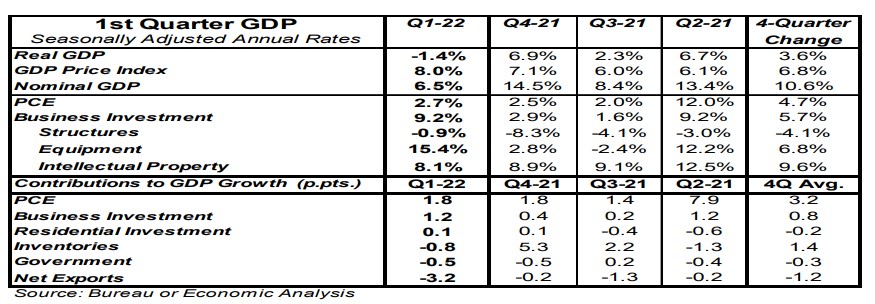- Real GDP declined at a 1.4% annual rate in Q1, widely lagging the consensus expected +1.0% rate.
- The largest negative drag on the real GDP growth rate in Q1, by far, was net exports, with inventories and government purchases also holding real GDP down. Consumer spending, business investment in equipment and intellectual property, as well as home building all increased in Q1.
- Personal consumption, business fixed investment, and home building, combined, grew at a 3.7% annual rate in Q1.
- The GDP price index increased at a 8.0% annual rate in Q1 and is up 6.8% from a year ago. Nominal GDP (real GDP plus inflation) rose at a 6.5% annual rate in Q1 and is up 10.6% from a year ago.
Implications:
Real GDP declined at a 1.4% annual rate in the first quarter, falling well below the consensus expected growth rate of 1.0%. Yes, you read that right: real GDP shrank in Q1, which is what happens during recessions. So, does this mean the Federal Reserve has already gotten tight and the economy is in a recession? No, not by a long shot. We believe a recession is eventually going to happen because the Fed will need to get tight to wrestle inflation under control, but the Fed is still far from tight and the decline in real GDP in Q1 isn't part of a recession. Expect a rebound in the second quarter. Consumer spending (+2.7% annual rate), business fixed investment (+9.2% rate), and home building (+2.1% rate) all increased in the first quarter, which is not something you'd see during a recession. These components make up what we call "core" GDP, which rose at a robust 3.7% annual rate. So why did real GDP drop in Q1? A host of factors that are probably temporary. First, a massive surge in imports, which resulted in a drag of 3.2 percentage points on growth. Second, inventories rose at a slower pace than in the last quarter of 2021, bringing real GDP growth down another 0.8 percentage points. Third, government purchases declined, accounting for a further drag of 0.5 points. Nor should investors expect today's GDP report to slow the Fed's pace of rate hikes or Quantitative Tightening. GDP prices rose at an 8.0% annual rate in Q1, the fastest pace for any quarter since 1981. GDP prices are up 6.8% from a year ago, nowhere near the Fed's 2.0% target. Nominal GDP (real GDP growth plus inflation) rose at a 6.5% annual rate in Q1 and is up 10.6% from a year ago. The US economy recovered rapidly from re-opening in 2021, with real GDP up 5.5%. That period of rapid growth is now over. But that doesn't mean we should take the headline from today's report at face value and that a recession has already started. The Fed has a lot more work to do before monetary policy is tight enough to induce a recession. Other news this morning confirms the economy is not in recession. Initial claims for unemployment insurance declined 5,000 last week to 180,000. Continuing claims fell 1,000 to 1.408 million. In other recent news, pending home sales, which are contracts on existing homes, declined 1.2% in March after falling 4.0% in February, suggesting a decline in existing home sales (counted at closing) in April.





